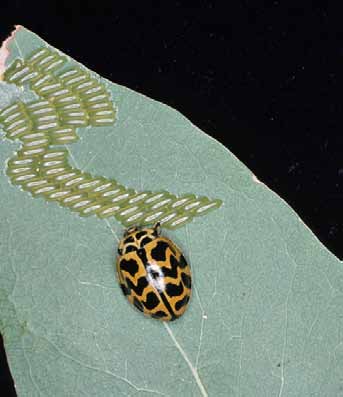PESTS AND DISEASES OF FORESTRY IN NEW ZEALAND
Forestry ladybird helps horticulture?
Scion is the leading provider of forest-related knowledge in New Zealand
Formerly known as the Forest Research Institute, Scion has been a leader in research relating to forest health for over 50 years. The Rotorua-based Crown Research Institute continues to provide science that will protect all forests from damage caused by insect pests, pathogens and weeds. The information presented below arises from these research activities.
From Forest Health News No. 224, April 2012.
Cleobora mellyi, an Australian ladybird was introduced into New Zealand from Tasmania in 1977 for control of the eucalyptus tortoise beetle, Paropsis charybdis. This Australian tortoise beetle, which was first found in New Zealand in 1916, is a serious defoliator of eucalypts here.

Between 1979 and 1987 thousands of Cleobora adults were released in eucalypt plantations in the central North Island and Christchurch and in the Marlborough Sounds in a mixed eucalypt and acacia plantation. Adults were subsequently found overwintering under bark in the latter release site, and Cleobora established there.
Cleobora is a voracious feeder of Paropsis eggs but also needs psyllids in its diet to enhance its fecundity; without psyllids the beetles lay very few eggs. It is highly likely that Cleobora did not establish in the other release sites because of a paucity of psyllids; at the Marlborough Sounds site there were good populations of psyllids on Acacia melanoxylon.
In the early 2000s concern was mounting about the amount of damage on Acacia melanoxylon caused by Dicranosterna semipunctata and it was about the same time that Cleobora were found feeding on D. semipunctata eggs on A. melanoxylon. This resulted in a Ministry of Agriculture Forestry Sustainable Farming Fund funded project involving the Acacia melanoxylon Interest Group Organisation (AMIGO), the Eucalyptus Cooperative and Scion. The project involved collecting Cleobora from the field in the Marlborough Sounds and mass rearing them for release. This was done at about 18 locations, mainly in the North Island but also in Southland.
In addition to the Marlborough Sounds Cleobora is now known to be established Northland, Auckland, Waikato, Coromandel, Bay of Plenty and Southland.
In 2009 it was reported that Zonda Resources Ltd and Plant and Food Research were using Cleobora in trials to control the potato-tomato psyllid (Bactericera cockerelli) in tomato and capsicum crops. This psyllid was first found in New Zealand in 2006 and is now found through most of the country. This work is being taken further by the Bio-Protection Research Centre at Lincoln (see http://straightfurrow.realviewtechnologies.com/?iid=61796&startpage=page0000001#folio=1.
We will watch with interest to see how the field trials with this novel host/prey association work out. There are several good examples of biological control using such associations.
John Bain
This information is intended for general interest only. It is not intended to be a substitute for specific specialist advice on any matter and should not be relied on for that purpose. Scion will not be liable for any direct, indirect, incidental, special, consequential or exemplary damages, loss of profits, or any other intangible losses that result from using the information provided on this site.
(Scion is the trading name of the New Zealand Forest Research Institute Limited.)

 Farm Forestry New Zealand
Farm Forestry New Zealand

